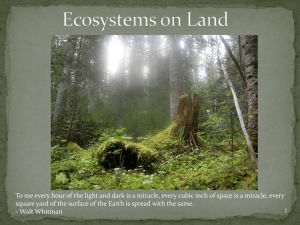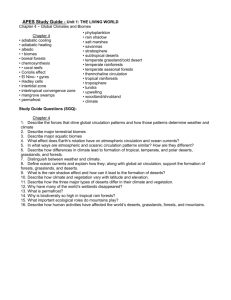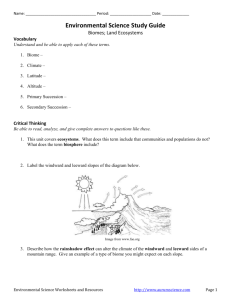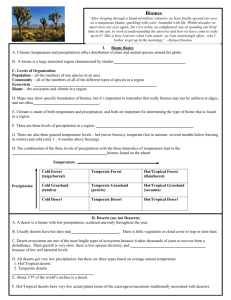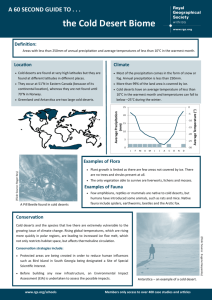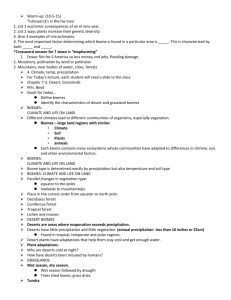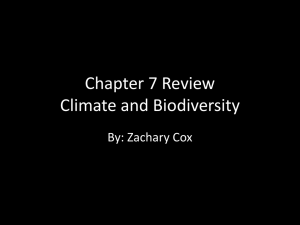Land Ecosystems and Ecological Succession
advertisement
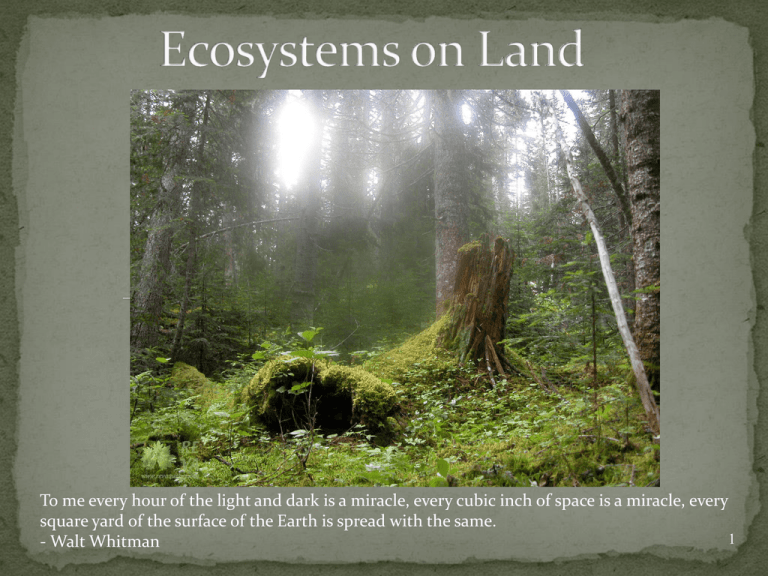
To me every hour of the light and dark is a miracle, every cubic inch of space is a miracle, every square yard of the surface of the Earth is spread with the same. 1 - Walt Whitman Photo by Harm de Blij, Michigan State University. 2 Hispaniola (“The Spanish Island”) is an island that Christopher Columbus took possession of during his voyage of 1492. Columbus Landing on Hispaniola, 1492. Artist: Theodor de Bry, 1594. 3 Hispaniola had a wide variety of ecosystems, ranging from arid plains to lush tropical forests. Five mountain ranges run through the island. Los Haitises National Park, Dominican Republic 4 As the island was colonized, most of its indigenous tribes died out from diseases and harsh working conditions in Spanish gold mines. By 1517, the indigenous population was down to from an estimated 250,000 to 14,000. They were replaced with 14,000 African slaves and 1,000 Spanish colonists on the island. 5 The slave population revolved in 1804, winning independence from France for Haiti, their part of the island. Initially, no nation would recognize the country as sovereign. France demanded 150 million Francs as restitution for lost property, which was paid with lumber from the island’s forests. Battle at San Domingo. Artist: January Suchodolski, 1845. 6 The biosphere is the part of the Earth that supports life. Scattered throughout the biosphere is a wide range of habitats– dry deserts, lush rainforests, even dark caves. Each of these areas, called biomes, has its own unique geography and climate. 7 The two most significant abiotic factors that influence life in a biome are temperature and precipitation. 8 As the latitude, or distance away from the equator, increases, average temperature tends to decrease. 9 Latitude is measured in degrees north or south of the equator. 10 As the altitude, or elevation from sea level increases, average temperatures decrease. 11 In addition to changing altitude, the presence of mountains has a major influence on the distribution of precipitation. As warm, moist air travels up a mountain range, the air cools (due to altitude) and the moisture condenses. 12 As a result, the windward side of the mountain facing the incoming air currents receives disproportionately more precipitation than the opposite, leeward side. This is called the rain shadow effect. 13 Biomes located near a large body of water often have greater precipitation levels and milder, more stable temperatures. Water gains and loses heat much more slowly than air. The nearby water evaporates and fuels incoming storm systems. 14 Vegetation map of the world. Source: NASA and NOAA. 15 A climatograph is a combination precipitation and temperature graph for a given biome. The average montly precipitation for the area is displayed as a bar graph. The average monthly temperature is displayed as a line graph. 16 Lowest moisture levels of all ecosystems. Precipitation is infrequent and unpredictable. The lack of water is a major limiting factor for plant growth. The lack of plants, in turn, is a limiting factor for any other consumer or decomposer. 17 Subtropical deserts are usually located in the interior of continents, far from sources of moisture. Wind patterns also prevent any moisture from collecting. The Sahara Desert in Africa and the Great Australian Desert are examples. Kalahari Desert, Botswana, Africa Planet Earth, Deserts, 2006. Namibia. 19 Rain shadow deserts are formed primarily due to their position on the leeward side of a large mountain range. The Gobi desert falls on the leeward side of the Himalayan mountains. 20 The Atacama Desert in Chile is the driest place on Earth, outside of Antarctica. Some weather stations have never recorded any rainfall! This is a coastal desert. The ocean water cools the air so much that it is unable to hold moisture well. The Andes Mountains form a rain shadow effect on the opposite side. 21 Planet Earth, Deserts, 2006. The Atacama Desert in Chile. 22 Midlatitude, or temperate deserts fall in higher latitudes, between 40 and 60 degrees. This means much more temperature variability, including different seasons. Temperate deserts receive somewhat more precipitation than subtropical deserts, supporting plants adapted to the climate. The Sonoran Desert in the southwestern United States is an example. Many temperate desert plants are succulents, meaning they have thickened, fleshy parts for storing water. Succulent plants also grow very slowly. The Saguaro cactus grows 75 years before sprouting its first arm! Saguaro cacti, Carnegiea gigantea Sonoran Desert, Arizona, USA. Polar deserts consistently experience temperatures below freezing. The little precipitation that falls takes the form of ice or snow. Most of the interior of Antarctica is considered a polar desert. 250 year-old mummified seal carcass. McMurdo Dry Valley, Antarctica. Life in the freezer. Dir. David Attenborough. BBC Video ; 2005. DVD. 26 Grasslands receive more precipitation and cooler temperatures than deserts. With water being less of a limiting factor, more biomass is found here than in deserts. 27 Tropical grasslands, also called savannas, are located near the equator, usually between desert and rainforest biomes. Savannas have consistent temperatures. The seasons are instead based on precipitation. Temperate grasslands, called prairies in North America, are farther away from the equator and experience seasonal temperature shifts. Prairie plants have adapted to the cold winter and frequent absence of precipitation by developing root systems that can be several feet deep. This enables prairie plants to recover quickly from drought or wildfire, while the slow growing trees cannot. 30 Planet Earth, Great Plains, 2006. Mongolia. 31 Polar grasslands, also called tundra, are below freezing most of the year. Limiting factor is temperature. Due to the short growing season, only the top layer of soil actually thaws and can support plant life. The rest is permafrost. 32 There is a growing season in the tundra, but it is only a few months long. Only lichens, herbs, and other small plants survive there. 33 Forest biomes receive much more consistent precipitation than deserts and grasslands, allowing them to support hardwood trees. 34 Tropical rainforests receive the greatest amount of rainfall of any other biome and are consistently warm. Few abiotic limiting factors for plant growth. Rainforests are so dense with life that they are divided into four layers: Emergent layer Canopy Understory Forest Floor 35 The emergent layer and canopy contains the majority of the fruit, leaves, and flowers of the trees. Most of the animal life is also found in the canopy. Iguaçu Falls, border of Brazil, Argentina, and Bolivia. 36 Planet Earth, Jungles, 2006. The canopy. 37 The understory only receives about 5% of the sunlight that shines on the canopy. Contains shrubs, seedlings, and some animals. The forest floor is the darkest layer and is mostly home to decomposers like insect larvae and fungi. Despite the rapid decomposition rate, the nutrients are reabsorbed so quickly that the topsoil is very thin. Phallus indusiatus, Veiled Lady Fungus 38 Planet Earth, Jungles, 2006. The forest floor. 39 In Haiti, a combination of a severe hurricane in 1954 and increased demand for charcoal lead to further deforestation. The peasants began clearing and farming on the forested hills. The thin rainforest soil was quickly depleted and began experiencing severe erosion. 40 Temperate deciduous forests, located at higher latitudes, experience a winter that reaches below freezing. Like rainforests, these mostly contain broadleaf trees which are well-suited for absorbing sunlight. They are divided into the same layers – canopy, understory, and forest floor. The growth is not constant, so the soil is actually much deeper and richer. 41 Winter poses a problem for these trees – the air is too dry for the trees to survive with their leaves intact. Deciduous trees adapt by shedding leaves when water is scarce or ground is frozen. Dandenong Ranges, Australia. 42 Planet Earth, Seasonal Forests, 2006. Deciduous Forest in Spring. 43 Temperate rainforests receive a comparable amount of precipitation to tropical ones, but are in higher latitudes. One example is the Northern Pacific coast of the United States and Canada, which has two geographic advantages: Located on the windward side of the Olympic mountain range. Receives constant moisture from the wind currents off the Pacific ocean. Issaquah, Washington, United States 44 Planet Earth, Seasonal Forests, 2006. Temperate Rainforest. 45 Boreal forests, also called taiga, are found throughout the far northern latitudes. These forests are characterized by coniferous trees, which are much more well-adapted to the long, cold, dry winters. Needle-shaped leaves have a waxy coating that retains moisture in the winter. Cone shape allows accumulated snow to slide to the ground. Fairbanks, Alaska, United States. 46 Planet Earth, Seasonal Forests, 2006. Taiga. 47 Biomes are dynamic – they change as the Earth changes. This process is called succession. Organisms that thrive during the early stages of succession are called pioneer species. Those only found in later stages are called climax species. Ecosystem succession takes two forms, depending on the starting point. 48 Primary succession occurs when a new ecosystem develops where there was none before. A combination of wind, water, and pioneer species such as lichens break down rock into soil. Once the soil has enough organic matter, small plants and shrubs can be supported. Over time, trees spout and become dominant. 49 Secondary succession occurs following the disruption of an existing ecosystem. Fire, flood, volcanic eruption, clear-cutting, etc. This form of ecological succession does not take as long. Soil is already in place, and pioneer species appear within days or weeks. 50 Planet Earth, Jungles, 2006. Ecological Succession. 51 Today, only about 2% of Haiti’s original forest cover remains. Even this remains at risk, because most of the people depend on charcoal as a source of heat. The lack of forests has made the country much more susceptible to flooding, mudslides, and erosion. 52 Neighboring Dominican Republic, which gained its independence with much less strife, is the second largest economy in the Caribbean. 53 Haiti’s hopes for recovery hinge on its ability to speed the process of ecological succession – to encourage reforestation and find an alternative fuel to charcoal. 54


